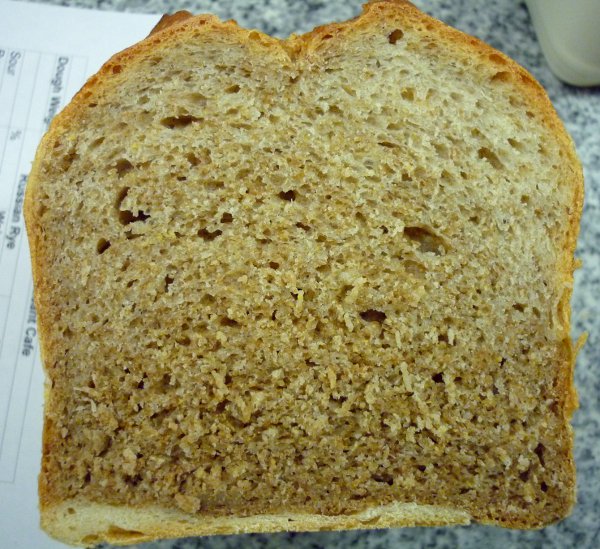For a while now I was thinking how to incorporate several doughs with different rye:wheat ratios into a single loaf, for various purposes( aestatics, spot the difference ...).
On the weekend I had some spare time and went the whole way (that's the madness component)
Using my single-step Detmolder formula I made 9 doughs with rye:wheat ratios of 20% to 100% and a simple white yeasted 100% wheat dough to wrap it all up.
I decided to bake this in a 1000g loaf tin. The flat rectangular pieces of dough were stacked on a bigger sheet of white dough (lower rye % first), and the white dough wasthen wrapped around, to give this thing some kind of structure.
This is the result, and I am rather pleased with it:

The white bit at the bottom is the seam /overlap of the white dough sheet. Just above is a thin layer of 100% rye, then 90% etc.
With 10 layers the transition between the layers is almost invisible.
An interesting experience,
Juergen
but as long as you had fun, right? Did this loaf come to you in a dream? If not, what was the inspiration?
Thanks for sharing!
the UK TFLers were called to a meeting (happening this February) and were asked to brimg something to show and tell...
I asked myself if I could get several of my favourites into a single loaf. That was the starting point.
I thought about something along the lines of marbeled rye, or the pane al latte e cioccolate in "The Italian Baker". This bread uses two doughs of similar consisnency and with similar expansion.
What I wanted to do is something where the different ingredients have a different rate of expansion (during final proof and bake), Braids wouldn't look great.
I found this to be an interesting challenge in itself, and my loaf above is my first attempt to put this to reality.
The recipe I use is very suitable for this because it is designed for a production environment; I can be certain that the 100% rye, 50% rye and 20% rye parts all mature at the same time.
I can see where I can improve this tinned loaf - the white dough is stretched too thinly and has a completely different consistency - maybe the "envelope" layer ought to be a thick 20% rye sheet? This might also give the "deeper" layers a better chance to expand.
My big challenge here is shaping. (And proper dough development with 110g portions)
Fun it was to make, and it is fun for me to eat this bread where every bite tastes different.
Thanks for the reply,
Juergen
Juergen,
The proofing was the part I found to be most impressive (or craziest). You say your recipe makes sure the 100%, 50%, and 20% rye are ready together? Do you make all doughs at once or spaced out over the course of the day? This bread seems like all of the planning for a bakery production schedule in one loaf.
I made them all at the same time - I put the dry ingredients into 10 plastic pots and then just added starter and water and mixed with a fork. That took about 2 minutes per pot. Then I started at pot 1 to do folds.Fough development is a real problem with 110 g portions, but s&f works well. The doughs above 60% rye just need mixing.
My wife had a strange look on her face when she saw the row pots in the kitchen...
The doughs had to be ready at the same time, because I then would put them together into one tinned loaf.
I am not a professional baker, but I doubt this will ever make it into a bakery.
The formula is based on a post in Wolfgang Suepke's blog, where he explains about his production schedule and the amount of yeast used to make a turnaround of one bake per hour possible.
I am always amazed how precise this formula works under my circumstances, whether I make bread with 30%, 70% or 100% rye.
an interesting concept. But the different doughs need to have the same baking temperature, either both enriched or both lean?
Karin
Hi Karin, Nice to hear from you.
The doughs I used are all based on the same formula. Suepke gives details how to vary the percentages of water and starter for different rye contents while keeping the parameters for fermentation and baking the same.
This seems to be a common concept for sourdough processes (Sauerteig-Fuehrungen) in Germany, I found similar information for Detmolder 3-step, Mohnheimer Salzsauer and Berliner Kurzsauer as well.
I put that into a spreadsheet which I use for my Detmolder single step breads.
This way the doughs are all siblings, if you want, and perform nicely together. I just have to deal with the different density and stickyness. And possibly shaping.
Viele Gruesse,
Juergen